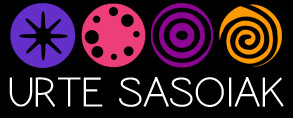VIDEO SCRIPT
It is the beginning of December. The night has taken hours of time from the day, and the afternoon has become significantly shorter. Not to worry though, because the opposite process will soon start: the day will gain hours of sunlight, and night-time will cut short.
This was a well-known fact by men and women of times past. Shepherding was their occupation. As modern calendar systems had not yet been developed, the Moon, Nature and the Sun would be their reference points. They noticed that the passing of time followed a cyclic pattern. Days became longer for some time, and all of a sudden, the lengthening process would come to a stop around 21 and 24 June in nowadays calendars. Later the direction of the Sun is reversed and days began to shorten until the Sun reaches its furthest point again, around 21 and 24 December in our calendar.
Those times of the year are known as the summer and the winter solstices. The two solstices or eguzkiaren itzul-mugak, as Barandiaran referred to them (which literal translation is the Sun’s turning points), acquired great significance for those men and women. The solstices determined the start and the end of their years, and their major celebrations and events arisen around those dates.
This unit deals with the winter solstice celebrations. We shall try to study Christmas time holidays and customs observed in Euskal Herria. Before we do that, though, let us remember the dual nature of the festivities celebrated at this time of the year: on the one hand, these are days, Eguberriak (literally New days) meant to rejoice precisely for the time of the year, and on the other, the Christmas season, Gabonak (Merry nights commemorating the birth of Jesus Christ) has been filled with a Christian spirit acquired through the centuries.
Saint Nicholas’ Day is celebrated on 6 December. The feast is popularly known as obispo txiki (little bishop) in many localities of the Basque region, or as obispillo, the Spanish word with the same meaning, in Gasteiz. On the day it is customary to go on an alms round door to door, greeting the household members and dedicating verses to each member or singing about the birth of Christ.
In the olden times, young boys from different parish associations would dress in bishop clothing. This is something that often happens at Christmas, and particularly at Carnival time. There is, so to say, a breach of order and law brought about by a change in the chronological passing of time, which in turn results in joy and celebration.
We are in Gernika. Marijesiak songs are performed during the nine days before Christmas Day. The exit round starts at four o’clock in the morning, and the group marches through the streets of the village singing verses that narrate episodes from the sacred history since the times of Adam and Eve to the birth of Jesus Christ. The soloist sings and the rest of the marches answer.
During the Christmas festive season, singing is a major part of the celebrations in Euskal Herria. It is 24 December. Early in the morning, the streets bulge with groups of singers performing.
Olentzero is here too. Even if he is widely depicted as an idle peasant in the modern version, the ancient prehistorical figure might have been a mighty character related to the Sun God, perhaps.
There are many variations to the figure of Olentzero, sometimes varying from village to village. In some places he is a fisherman, in others a charcoal-burner; he can have a huge appetite and thirst… He is portrayed as having an ungraceful manner, and at the same time he is the bringer of news about Jesus’ birth. He is, in fact, the last member of a mythological race of Basque giants known as the jentilak people.
In some localities nativity scenes are carried on shoulders. This is a fairly new tradition. Villagers walk door to door singing carols while carrying nativity scenes on shoulders.
We have mentioned that wassailing, oles egitea, is a deeply-rooted Christmas tradition. In the afternoon adults take their turn to come out, sing and keep up the good spirits. House-visiting wassailing takes place on Christmas Eve, New Year’s Day and Three Wise Men Day, mainly.
The Christmas songs sung in the rounds from house to house are the most ancient popular stanzas. Permission is asked to sing at each house, and sets of verses are delivered to each member of the household. This customs is also present in other festivities around the year, such as Saint Agatha, Carnival and Saint John.
In some regions the head of the household would bless the bread at Christmas Eve supper. A piece was cut and kept in a well-known place for a whole year and was then thrown into the fire or somehow got rid of. The saved piece of bread was thought to have magical powers: it cured rabid dogs, protected the house from lightning, looked after the crops, and so on.
It is 31 December, New Year’s Eve. There are different customs to celebrate the end of the year.
In some villages of Araba, in Agurain for instance, on New Year’s Eve a puppet is walked through the streets. The puppet represents the old year and is finally burned in flames. Burn, burn its backside!
It is the morning of New Year’s Day. Children take a chance to go on an alms round. In the past they were given walnuts, hazelnuts, chestnuts, eggs, and a few coins, if they were lucky.
The last festivity of the Christmas holiday is the Three Wise Men Day. There is a variety of events to celebrate the occasion, but most of them take place on the eve. The Trufania tradition or Neguko Festa Berria, Winter Corpus Christi feast, in Donibane Lohizune and its infant Magi. And the Three Kings Parade, which is probably the best known. There are more, though not so renowned. On Epiphany morning children would go round the neighbouring houses reciting songs such as Erregen-erregen or Apalazio zalduna.
Christmas in Euskal Herria is a time brimming with beautiful ancient traditions. Let us hope that knowing about them shall make us appreciate and preserve them.




